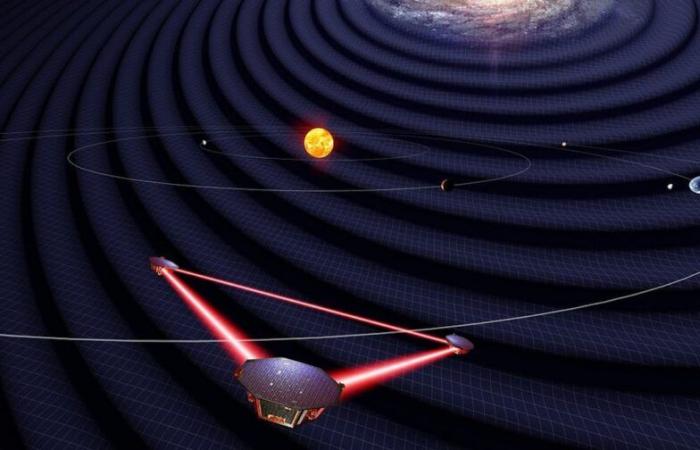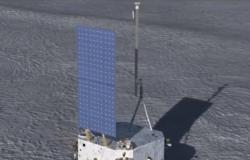Lisa is the first scientific effort to study gravitational waves from space. It will detect, throughout the universe, the waves in the space-time caused by the collision of huge black holes in the centers of the galaxies. It is a high -flight commitment to the European Space Agency (ESA).
To understand the revolution of gravitational waves, and the scientific challenge that Lisa supposes, you have to go back to its discovery.
Again, Einstein was the beginning
At the beginning of the last century, Albert Einstein radically changed the concept of gravity that Newton thought of the 18th century. Instead of being a distance force between bodies with mass, gravity becomes the manifestation of the curvature of space and time produced by the presence of mass and energy. This provides us with a different explanation of the movement of the planets around the sun.
Indeed, our star, the most massive object with the difference of the solar system, produces a deformation of the space around yours that affects the movement of the planets.
As in Newtonian Physics, physical objects describe trajectories of minimal effort (minimal action), in general relativity follow the shortest paths between two points of space-time geometry. In the case of the Sun, the consequence is that the planets follow the elliptical orbits that Johannes Kepler has already predicted at the beginning of the 17th century.
Einstein’s general relativity prevents Newtonian distance action. In addition, it incorporates the gravity within the relativistic physics that it proposed. The same that served to make the laws of electromagnetism and the laws of movement in harmony.
Electromagnetism and general relativity are relativistic theories that share the same space-time structure. An inevitable consequence is the existence of gravitational waves, in the same way that electromagnetic waves (light) exist.
The French mathematician and physicist Henri Poincaré already deduced even before Einstein formulated his theory. He even predicted that they travel at the speed of light, as later demonstrated the general relativity.
Thus they were detected
In 1916, Einstein saw that his theory predicts the existence of gravitational waves and studied their properties. However, they were not directly detected until almost a century later, in 2015, and supposed the 2017 Nobel Physics Prize.
The main obstacle to registering them is the extremely weak effect of gravity on matter. This makes changes in space-time geometry that gravitational waves produce, which translate into changes in distance between mass objects, are tiny. A technology was needed to the limit of what is currently possible, and a cosmic cataclysm, so that the American observatory LIGO detected them for the first time.
The first detection was produced by a binary system of black holes (each had about thirty solar masses) whose orbit was reduced, due to the emission of gravitational waves, until they collided. Since then, Ligo and other land detectors (Virgo in Italy and Kagra in Japan) have registered another 90 detections, and many more are expected shortly.
The rapid growth of astronomy with gravitational waves has produced a revolution whose impact on fair astrophysics has just begun. The next thing is to go beyond the scope and precision of land gravitational wave detectors such as Ligo and Virgo.
Massive black holes
One of the great scientific objectives is to observe supermassive black holes with gravitational waves. These have a cosmological origin and can be the key to answering some questions: structures such as galaxies were formed in the universe? Are black holes as the general relativity tells us? Is the same theory of correct general relativity in the presence of gravitational fields? …
Why a gravitational wave observatory in space
The binary supermassive holes binary systems emit low frequency gravitational waves. But it turns out that the land gravitational field presents fluctuations at these frequencies that make detection impossible. Therefore, we need a gravitational wave observatory in space. In this sense, the European Space Agency (ESA), with the participation of NASA, selected in 2017 the smooth mission (space antenna of laser interferometry, for its acronym in English).
Lisa will consist of a triangular constellation of three spacecraft, separated by 2.5 million km, which will follow the earth, at a distance of about 50 million km, in its orbit around the sun. The ships of the smooth constellation contain masses in free fall whose relative distance between ships will be monitored by laser light beams. Finally, interferometric measures with these lasers will allow us to predict the passage of gravitational waves.
The road to Lisa has been long and has been decades of technological and scientific developments. This includes a precursor mission, Lisa Pathfinder (ESA), which in 2016-17 demonstrated the fundamental principle of Lisa’s measure.
Important Spanish participation in Lisa
The Institute of Space Sciences (ICE) of the CSIC, within the framework of the Institute of Space Studies of Catalonia (IEEC), has played a very important role in Lisa Pathfinder, leading the data and diagnostic subsystem. He will also play it in Lisa, for which the scientific diagnostic subsystem will be provided, one of the four great mission subsystems. A mission data center will be created, from where the development of gravitational wave signal detection algorithms will be contributed.
Lisa is currently in the implementation phase after its design was adopted by ESA in early 2024.
About ten years of technological developments will be needed to launch Lisa by 2035. In this way, the first spatial observatory of gravitational waves will be in orbit.
Until the horizon of black holes
Lisa will provide us with the closest vision ever obtained from the primitive universe, accessing physical processes of high energies, of the same magnitude of the energies involved in particle accelerators such as CERN. It will also allow us to explore the structure of the horizons of the black holes.
Similarly, we can verify to what extent the general relativity is valid in extreme gravitational fields, not explored so far, including the possibility of observing gravitational quantum phenomena.
Lisa’s potential for revolutionary discoveries is enormous, thanks in part that a window will open to the unexplored universe so far. Stay attentive.






